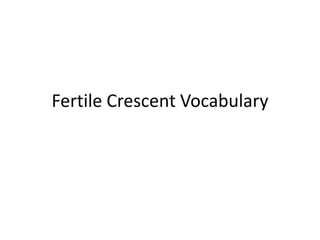Fertile crescent vocabulary
- 2. Geography of the Fertile Crescent • Mesopotamia– Greek word that means “between the rivers.” It is located between the Tigris and Euphrates rivers
- 3. Geography of the Fertile Crescent • Fertile Crescent—a large arc of rich, or fertile, farmland. It extends from the Persian Gulf to the Mediterranean Sea. • Silt—a mixture of rich soil and tiny rocks. Silt is brought to Mesopotamia by the yearly flooding of the Tigris and Euphrates rivers.
- 4. Geography of the Fertile Crescent • Irrigation– a way of supplying water to an area of land. • Canals—human-made waterways • Surplus—more than what is needed. Irrigation allowed for Mesopotamia farmers to have a food surplus.
- 5. Geography of the Fertile Crescent • Division of Labor—the type of arrangement in which each worker specializes in a particular task or job. • In what ways did a division of labor contribute to the growth of the Mesopotamia civilization?
- 6. The Rise of Sumer • Sumerians—the people of the world’s first civilization. The Sumerians settled in Mesopotamia in 3000 BC • City-state—a central city and all the countryside around it.
- 7. The Rise of Sumer • Empire—land with different territories and peoples under a single rule. • Sargon—Akkadian emperor who extended the Akkadian territory. He built a new capital, Akkad, on the Euphrates river, near what is now the city of Baghdad. He was the first to have a permanent army.
- 8. The Rise of Sumer • Polytheism—the worship of many gods • Social hierarchy—the division of society by rank or class. • Ur—one of the earliest and largest cities of ancient Mesopotamia. It was located on the Euphrates river. Ur traded with people from distant lands such as India.
- 9. Sumerian Achievements • Cuneiform– the world’s first system of writing. • Ziggurat– a pyramid-shaped temple
- 10. Later Peoples of the Fertile Crescent • Babylon– city built on the Euphrates river, near what is now Baghdad, Iraq. It had once been a Sumerian city. Hammurabi became the city’s greatest ruler. • Hammurabi’s Code– a set of 282 laws that dealt with almost every part of daily life.
- 11. Later Peoples of the Fertile Crescent • Hammurabi’s Code Hammurabi’s Code is written in Cuneiform. Stele located in the Louver Museum
- 12. Later Peoples of the Fertile Crescent • Chariot—a wheeled horse-drawn cart used in battle. • Assyrians– group of people who in 900 BC began to conquer all of the Fertile Crescent. Their capital city was Ninevah. Their army was very well organized and skilled.
- 13. Later Peoples of the Fertile Crescent • Chaldeans—group of people from the Syrian Desert who defeated the Assyrian Empire. Their most famous king was Nebuchadnezzar. He rebuilt the city of Babylon. • Phoenicians—group of people on the western end of the Fertile Crescent. They were excellent sailors ,and traded with other people around the Mediterranean. They built the city of Carthage northern Africa. They created one of the world’s first alphabets, which is the basis for our alphabet.












